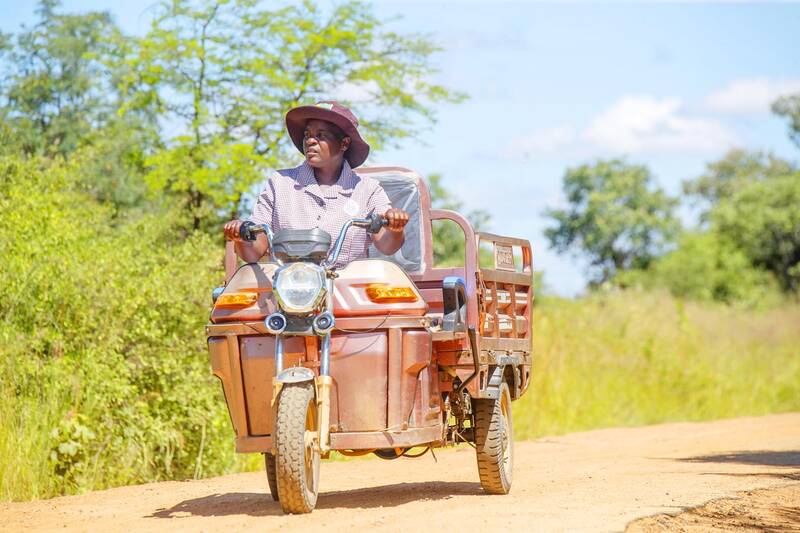Anna Bhobho, a 31-year-old housewife from rural Zimbabwe, was once a silent observer in her home, excluded from financial and family decisionmaking in the deeply patriarchal society. Today, she is a driver of change in her village, thanks to an electric tricycle she owns.
In many parts of rural sub-Saharan Africa, women have long been excluded from mainstream economic activities such as operating public transportation. However, three-wheelers powered by green energy are reversing that trend, offering financial opportunities and a newfound sense of importance.
“My husband now looks up to me to take care of a large chunk of expenses, including buying furniture and other assets,” Bhobho said at a market where she delivers crops for farmers in Wedza District, about 150km from Harare.

Photo: AP
Called Hamba, meaning “go” in Ndebele, the tricycles are powered by solar-charged lithium-ion batteries. Mobility for Africa, a local start-up, piloted the project in 2019 by leasing the vehicles to groups of women for US$15 a month. Today, women like Bhobho can own them through a lease-to-purchase program.
“I used to depend on my husband for everything, even money for bread,” she said.
Bhobho now owns land, has opened a small grocery store, is paying off a car and has moved her children from an underfunded rural public school to a better-equipped private institution. She earns up to US$300 a month, comparable to government workers such as schoolteachers.
Beyond material gains, she has gained self-esteem.
“Even my husband and in-laws have more respect for me now. No one used to listen to me, but now I have a seat when important decisions are being made,” the mother of three said.
Carlin Thandi Ngandu, the community engagement coordinator for Mobility for Africa, said 300 women across Zimbabwe are part of the program, with a goal of ensuring that 70 percent of the beneficiaries are women.
In Wedza, only women own and operate the tricycles. They receive training in safe driving skills, and swapping a lithium battery for a fully recharged one after about 100km costs US$1.
Motorcycles are a common public transport in sub-Saharan Africa, with some now switching to electric to cut fuel costs. The UN environmental program is introducing electric two and three-wheelers in nine countries, mostly in East Africa. In Nigeria, a green energy firm and the British Foreign Office are providing 120 electric three-wheelers to women, promoting sustainability and economic empowerment.
In Zimbabwe, the lives of many women have changed dramatically, even for those who do not own tricycles but use them for daily chores. Gone are the days of carrying firewood, buckets of water or heavy farm produce over long distances.
The tricycles, able to navigate narrow paths inaccessible to cars, reach remote homesteads and vegetable gardens. Their affordability makes them accessible to locals.
Hilda Takadini, a tomato farmer, said her business has flourished since she started using Bhobho’s transport services. Previously, she had to leave home at 3am, using an ox-drawn cart to travel 18km to the market. Often, she arrived too late or not at all, and her tomatoes rotted.
“I get better prices, because now I reach the market on time with my tomatoes still fresh. Even the children now know they can rely on me for school fees,” the 34-year-old mother of six said.
At Wedza shopping center, about a dozen women line up with their tricycles, which can carry loads of up to 450kg and have a top speed of 60kph, waiting for customers. They transport passengers, patients heading to hospitals and people carrying building materials such as bricks, groceries and firewood.
However, the women have to contend with challenges such as rough terrain worsened by rains, as well as a number of men resistant to seeing women lead in traditionally male-dominated spaces, Bhobho said.
Beyond business, the tricycles are revolutionizing healthcare access, particularly for women and children. Josephine Nyevhe, a volunteer community health worker, uses her tricycle to bring medical services closer to rural families.
On a recent afternoon, a group of mothers with children waited at a roadside. Nyevhe arrived on her tricycle, hung a weighing scale on a tree branch and began measuring the children’s growth. She recorded details in her notebook, offered nutrition advice and referred severe cases to the local clinic.
Many times, her tricycle has served as a village ambulance.
“I am on 24-hour standby. I get calls during odd hours and have to rush people to the hospital. Sometimes it’s a pregnant woman who would have otherwise given birth at home in unsafe conditions,” said Nyevhe, wearing her brown uniform.

Taiwan Semiconductor Manufacturing Co (TSMC, 台積電) secured a record 70.2 percent share of the global foundry business in the second quarter, up from 67.6 percent the previous quarter, and continued widening its lead over second-placed Samsung Electronics Co, TrendForce Corp (集邦科技) said on Monday. TSMC posted US$30.24 billion in sales in the April-to-June period, up 18.5 percent from the previous quarter, driven by major smartphone customers entering their ramp-up cycle and robust demand for artificial intelligence chips, laptops and PCs, which boosted wafer shipments and average selling prices, TrendForce said in a report. Samsung’s sales also grew in the second quarter, up

On Tuesday, US President Donald Trump weighed in on a pressing national issue: The rebranding of a restaurant chain. Last week, Cracker Barrel, a Tennessee company whose nationwide locations lean heavily on a cozy, old-timey aesthetic — “rocking chairs on the porch, a warm fire in the hearth, peg games on the table” — announced it was updating its logo. Uncle Herschel, the man who once appeared next to the letters with a barrel, was gone. It sparked ire on the right, with Donald Trump Jr leading a charge against the rebranding: “WTF is wrong with Cracker Barrel?!” Later, Trump Sr weighed

HEADWINDS: Upfront investment is unavoidable in the merger, but cost savings would materialize over time, TS Financial Holding Co president Welch Lin said TS Financial Holding Co (台新新光金控) said it would take about two years before the benefits of its merger with Shin Kong Financial Holding Co (新光金控) become evident, as the group prioritizes the consolidation of its major subsidiaries. “The group’s priority is to complete the consolidation of different subsidiaries,” Welch Lin (林維俊), president of the nation’s fourth-largest financial conglomerate by assets, told reporters during its first earnings briefing since the merger took effect on July 24. The asset management units are scheduled to merge in November, followed by life insurance in January next year and securities operations in April, Lin said. Banking integration,

LOOPHOLES: The move is to end a break that was aiding foreign producers without any similar benefit for US manufacturers, the US Department of Commerce said US President Donald Trump’s administration would make it harder for Samsung Electronics Co and SK Hynix Inc to ship critical equipment to their chipmaking operations in China, dealing a potential blow to the companies’ production in the world’s largest semiconductor market. The US Department of Commerce in a notice published on Friday said that it was revoking waivers for Samsung and SK Hynix to use US technologies in their Chinese operations. The companies had been operating in China under regulations that allow them to import chipmaking equipment without applying for a new license each time. The move would revise what is known